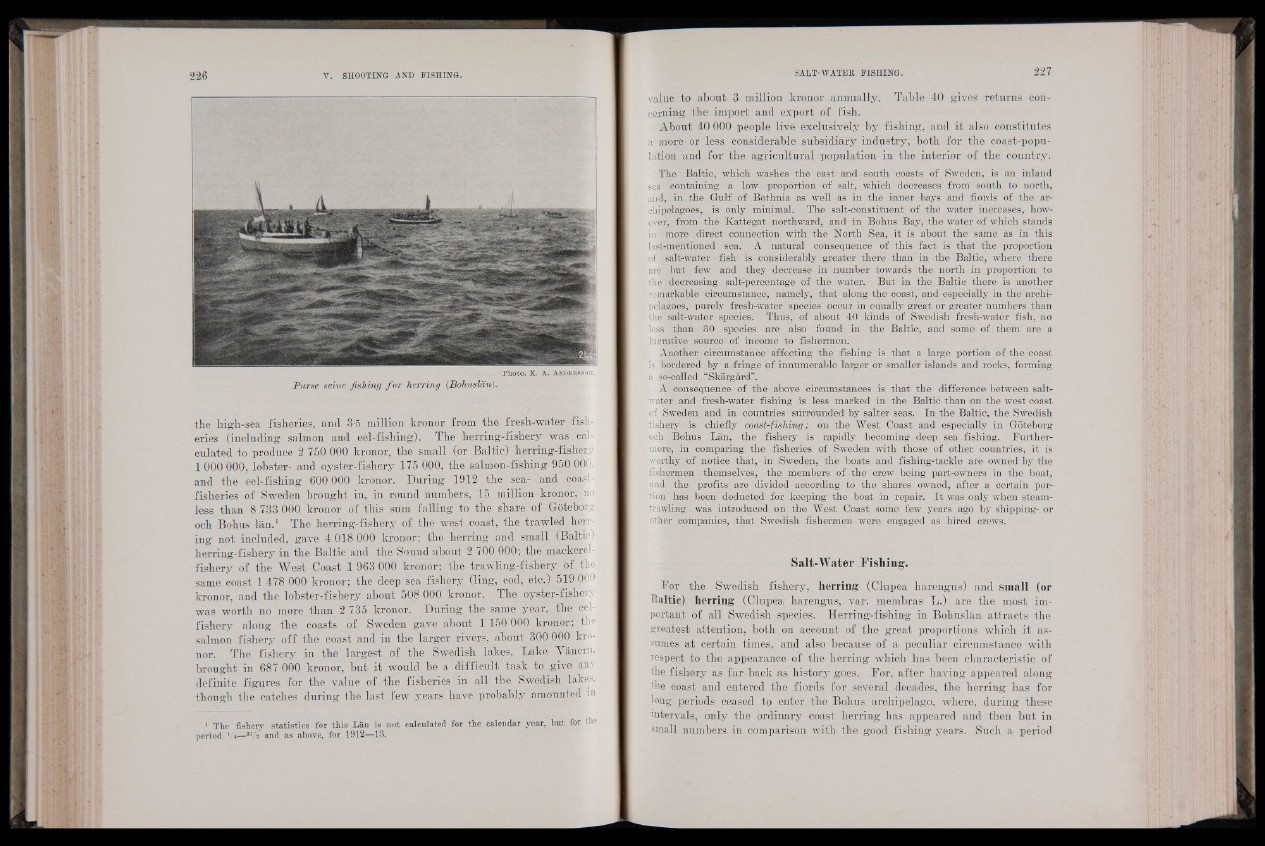
P h o to . K. A. Ander ssox .
Purse seine fishing f o r herring (Bohuslän).
the high-sea fisheries, and 3-5 million kronor from the fresh-water fisheries
(including salmon and eel-fishing). The herring-fishery was calculated
to produce 2 750 000 kronor, the small (or Baltic) herring-fishery
1 000 000, lobster- and oyster-fishery 175 000, the salmon-fishing 950 00(1
and the eel-fishing 600 000 kronor. During 1912 the sea- and coast-
fisheries of Sweden brought in, in round numbers, 15 million kronor,;, no
less than 8 733 000 kronor of this sum falling to the share of Göteborg
och Bohus län.1 The herring-fishery of the west ooast, the trawled herring
not included, gave 4 018 000 kronor; the herring and small (Baltic)
herring-fishery in the Baltic and the Sound about 2 ¿00 000; the mackerel -
fishery of the West Coast 1 963 000 kronor; the trawling-fishery of the
same coast 1 478 000 kronor; the deep sea fishery (ling, cod, etc.) 519 000
kronor, and the lobster-fishery about 508 000 kronor. The oyster-fishery
was worth no more than 2 735 kronor. During the same year, the eel-
fishery along the coasts of Sweden gave about 1 150 000 kronor; ;the
salmon fishery off the coast and in the larger rivers, about 300 000 kronor.
The fishery in the largest of the Swedish lakes, Lake Vänern,
brought in 687 000 kronor, but it would be a difficult task to give any
definite figures for the value of the fisheries in all the Swedish lakes,
though the catches during the last few years have, probably amounted in
1 The fishery statistics for this Län is not calculated, for the calendar year, but for the
period V«—s,/s and as above, for 1912JE13.
value to about 3 million kronor annually. Table 40 gives returns concerning
the import and export of fish.
About 40 000 people live exclusively by fishing, and it also constitutes
a more or less considerable subsidiary industry, both for the coast-popu-
lation and for the agricultural population in the interior of the country.
The Baltic, which washes the east and south coasts of Sweden, is an inland
sea containing a low proportion of salt, which decreases from south to north,
and, in .the Gulf of Bothnia as well as in the inner bays and fiords of the ar-
ehipelagoes, is only minimal. The salt-constituent of the water increases, however,
from the Kattegat northward, and in Bohus Bay, the water of which stands
in more direct connection with the North Sea, it is about the same as in this
last-mentioned sea. A natural consequence of this fact is that the proportion
of salt-water fish is considerably greater there than in the Baltic, where there
are;' but few and they decrease in number towards the north in proportion to
the decreasing saliPpercentage of the water. But in the Baltic there is another
remarkable circumstance, namely, that along the coast, and especially in the archipelagoes,
purely fresh-water species occur in equally great or greater numbers than
the¥ salt-water species. Thus;-of about 40 kinds o f Swedish fresh-water fish, no
less; than 30 species are also found in the Baltic, and some of them are a
lucrative. source of income .to. fishermen.
Another circumstance; affecting the fishing is that a large portion of the coast
is bordered by a-fringe of innumerable larger or smaller islands and rocks, forming
a so-called “Skargard”.
A consequence of the above circumstances is that the difference between saltwater
and fresh-water fishing is less marked in the Baltic than on the west coast
of Sweden and in countries surrounded by salter seas. In the Baltic, the Swedish
fishery is chiefly coast-fishing; on the West Coast and especially in Gbteborg
och Bohus Lan, the fishery is rapidly becoming deep sea fishing. Furthermore,
in comparing the fisheries of Sweden with those of other countries, it is
worthy of notice that, in Sweden, the boats and fishing-tackle are owned by the
fishermen—themselves, the members of the crew being part-owners in the boat,
and the profits are divided according to the shares owned, after a certain portion
has been deducted for keeping the boat in repair. It was only when steam-
trawling was introduced on the West Coast some few years ago by shipping- or
other companies, that Swedish fishermen were engaged as hired crews.
Salt-Water Fishing.
For the Swedish fishery, herring (Clupea harengus) and small (or
Baltic) herring (Clupea harengus, var. membras L.) are the most important
of all Swedish species. Herring-fishing in Bohuslan attracts the
greatest attention, both on account of the great proportions which it assumes
at certain times, and also because of a peculiar circumstance with
respect to the appearance of the herring which has been characteristic of
the fishery as far back as history goes. For, after having appeared along
the coast and entered the fiords for several decades, the herring has for
long periods ceased to enter the Bohus archipelago, where, during these
intervals, only the ordinary coast herring has appeared and then but in
small numbers in comparison with the good fishing years. Such a period